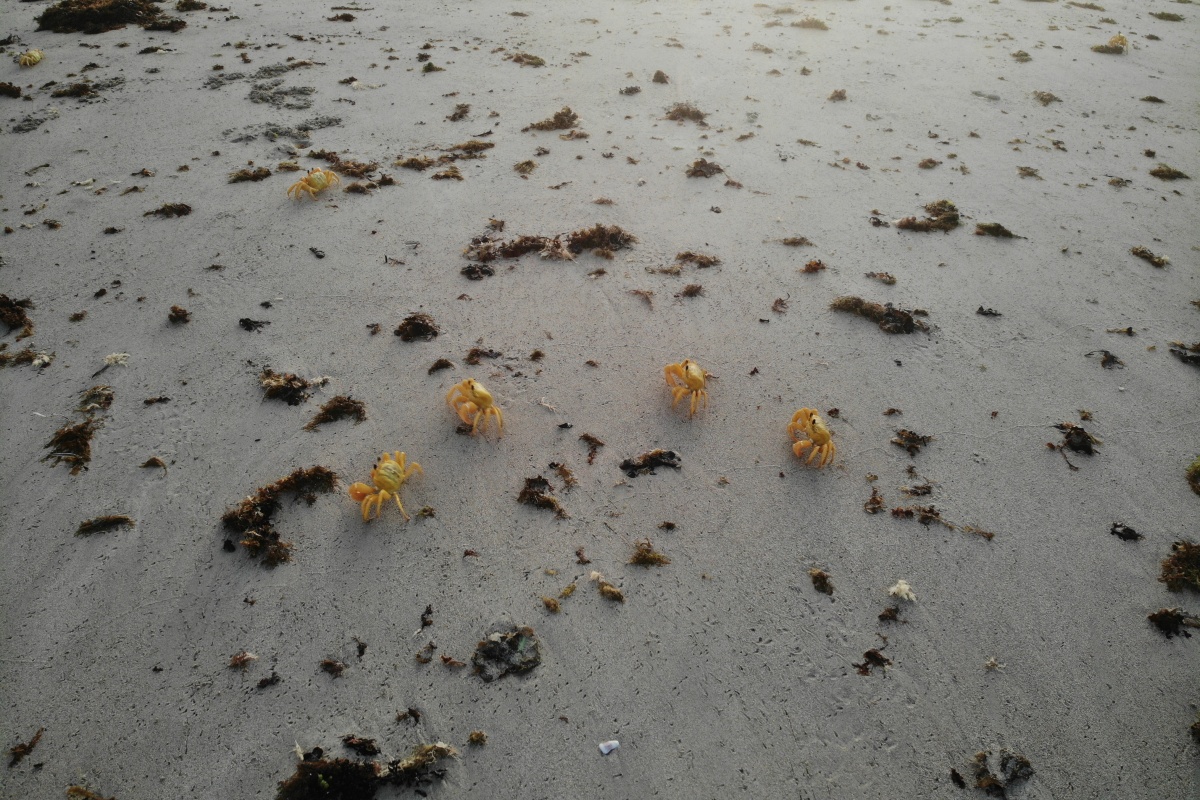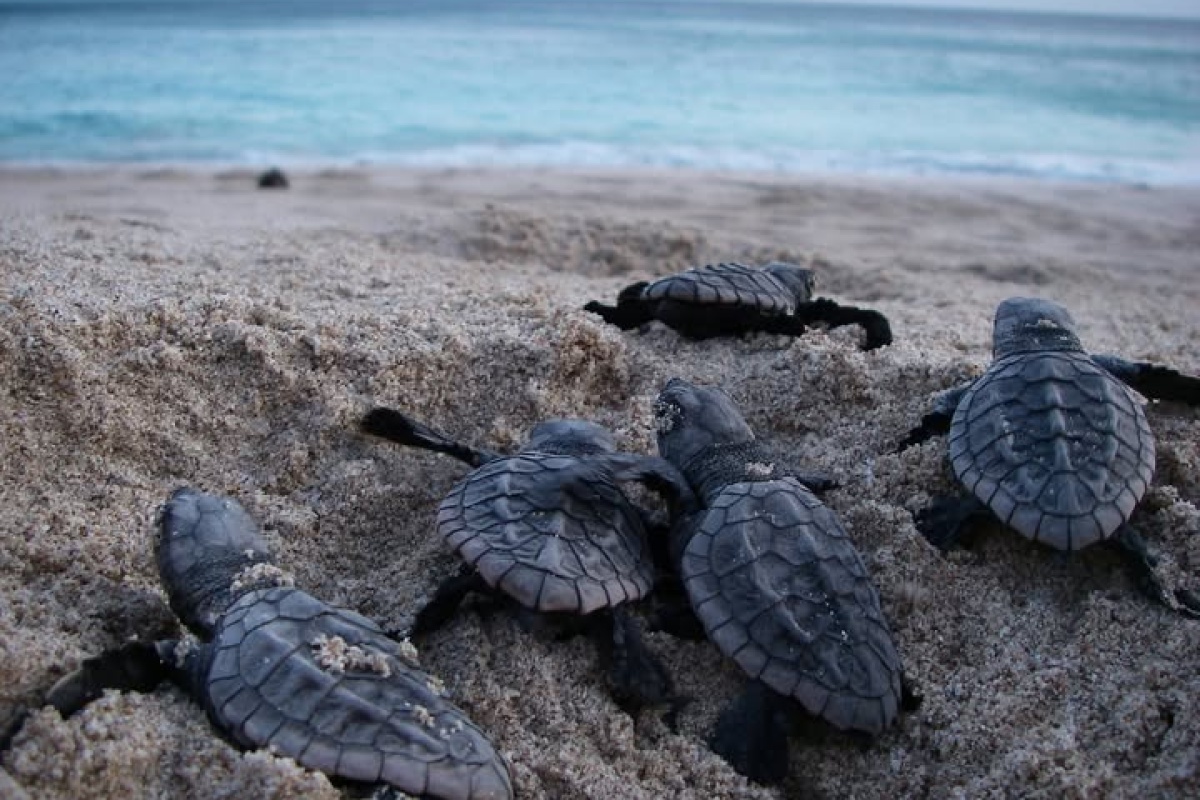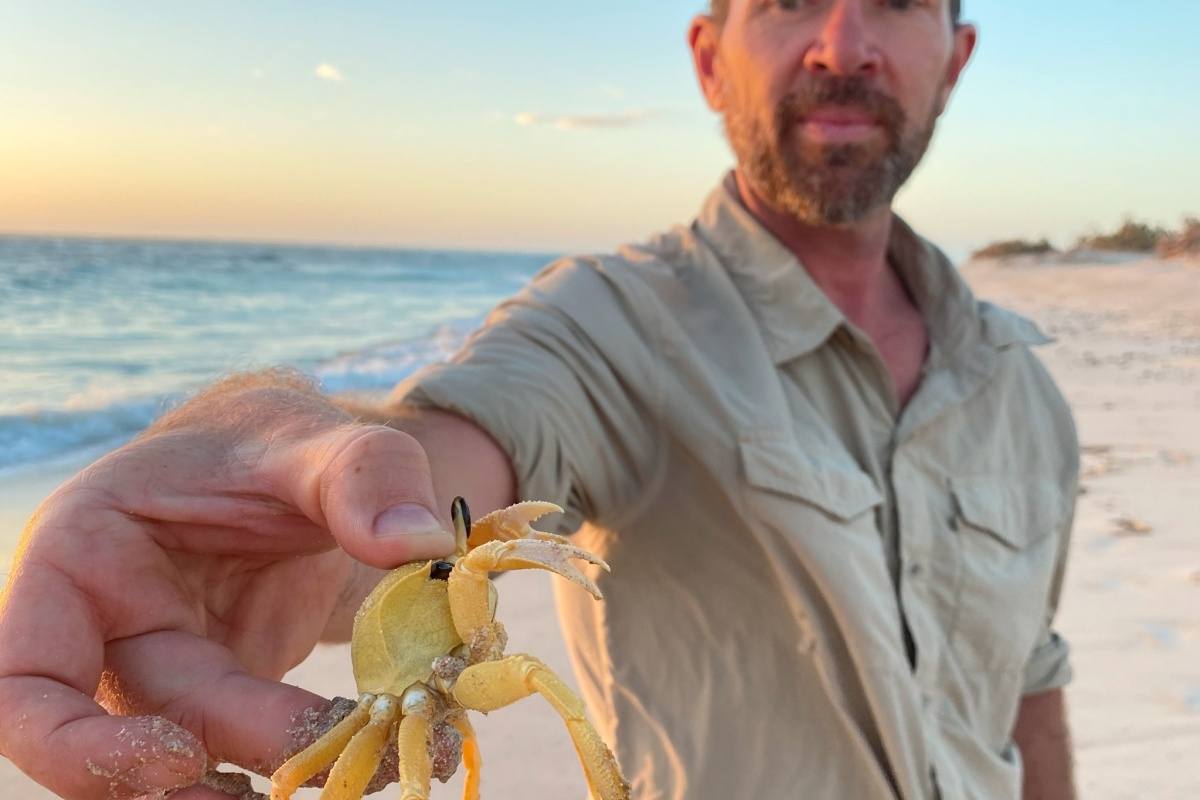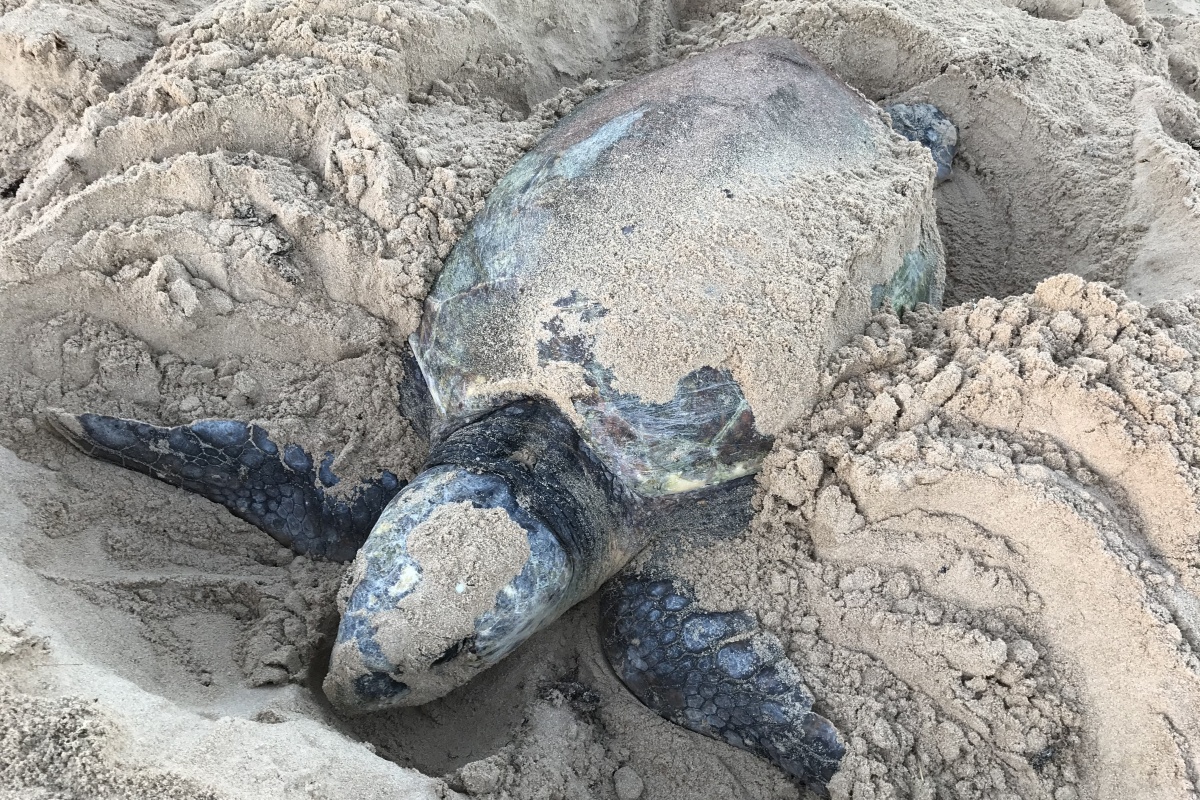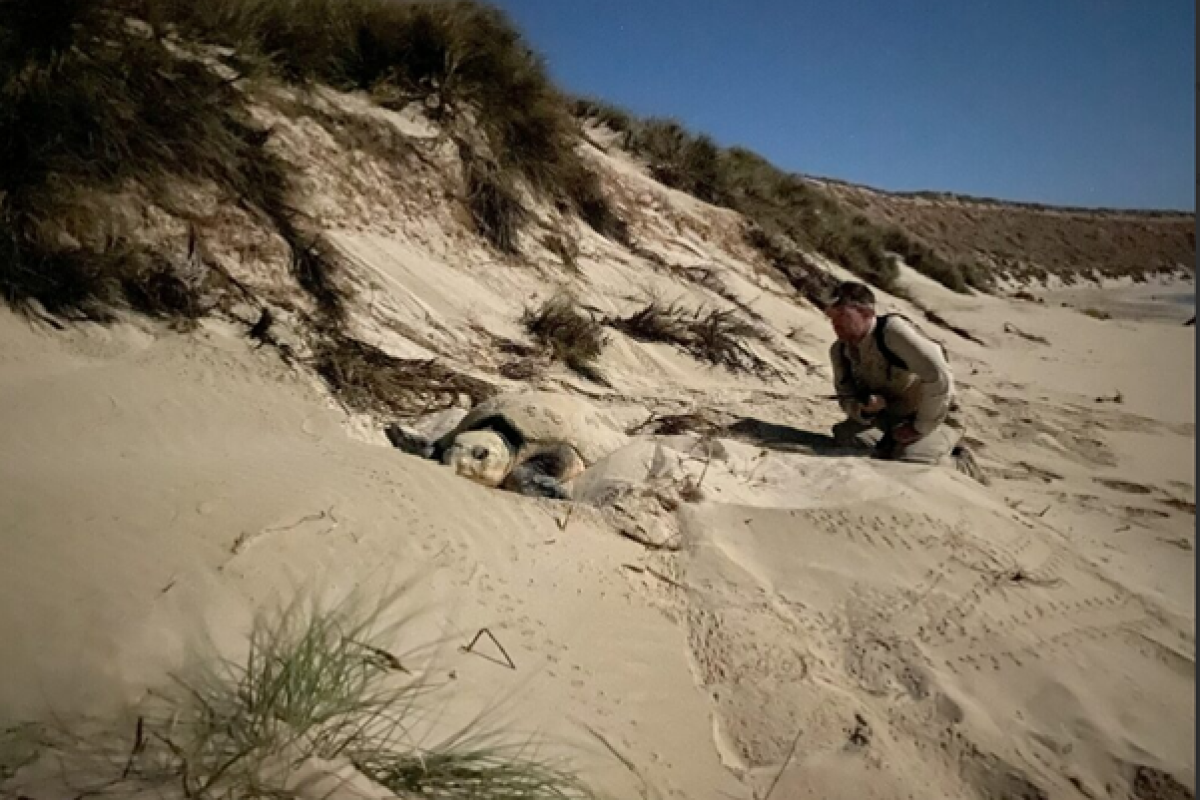As the sun dips below the horizon at Gnarraloo Bay, the Ningaloo Coast transforms into a stage of quiet drama. The waves of the Indian Ocean lap gently against beach sands, and the air hums with the anticipation of life. Beneath the surface, loggerhead turtle hatchlings, no bigger than a child’s hand, stir within their sandy nests, ready to embark on a perilous journey to the sea. Above, however, golden ghost crabs (Ocypode convexa) scuttle across the beach, their keen senses attuned to the faintest signs of life: vibrations, warmth, or the scent of nesting fluids. In this World Heritage-listed area, these small but formidable predators play a pivotal role in a delicate ecological dance, threatening the survival of one of the world’s most vulnerable sea turtle species while sustaining the vibrant beach ecosystem.
The Ningaloo Coast, stretching 300km along Western Australia’s remote western shoreline, is a place where marine, terrestrial, and cultural worlds converge. Home to the world’s longest nearshore fringing coral reef, it teems with more than 300 coral species, 700 reef fish, and charismatic megafauna like whale sharks and humpback whales.
Ningaloo’s beaches, framed by the dramatic limestone gorges of Cape Range, are critical nesting grounds for loggerhead turtles (Caretta caretta), a species listed as endangered under Australia’s Environment Protection and Biodiversity Conservation Act 1999 and WA’s Biodiversity Conservation Act 2016. Yet it’s the unassuming golden ghost crab that commands attention, acting as both a vital ecosystem engineer and a significant challenge to turtle conservation.
I recently completed research with Edith Cowan University and the Department of Biodiversity, Conservation and Attractions (DBCA) into these crabs and their interactions with loggerhead turtles at Ningaloo. This research reveals a complex interplay of predation, nutrient cycling, and cultural significance and offers insights into how we can protect Ningaloo’s fragile balance.
The Ningaloo Coast, known as Nyinggulu to the Baiyungu, Thalanyji, and Yinigudura people, is a living cultural and ecological masterpiece. For more than 30,000 years, these Traditional Owners have woven the region’s marine and terrestrial resources into their lives, from fish traps to turtle hunting, guided by Dreamtime stories.
“Ghost crabs was a big part of our traditional hunting,” Baiyungu Traditional Owner Hazel Walgar said. “As children, we were ordered by our elders to collect them all, we used to dig a hole on the beach and they would fall in and then we'd take them to the old people and they would crush them up, they would mix the crushed crabs with beach sand.”
“They would cast the crab and sand mix into the ocean, and this would bring in the spangled emperors. The fat served as food too. Us Nyinggulu mob only hunt the green sea turtles."
Today, these groups, empowered by the 2019 Gnulli Native Title Claim, co-manage the Ningaloo Marine Park and Cape Range National Park with DBCA, blending ancestral knowledge with modern conservation.
Geologically, Ningaloo is a marvel. Its fringing reef, built on fossil corals from 20,000 years ago, thrives in a narrow band of shallow waters, shaped by the warm Leeuwin Current and seasonal countercurrents.
These oceanographic forces create a unique tropical-temperate overlap, supporting rich biodiversity. The adjacent Cape Range, a karst limestone formation, harbors caves with subterranean fauna of ancient origin, while its red dune fields and wave-cut terraces frame turtle nesting beaches like Gnarraloo Bay and Bungelup Beach. These sites, alongside the Muiron Islands and Dirk Hartog Island in the Shark Bay World Heritage Area, are regionally significant rookeries for loggerheads, contributing five per cent of global abundance.
Loggerhead turtles are icons of endurance, migrating thousands of kilometres to nest on Ningaloo’s shores. Each summer, females haul themselves onto beaches, digging nests to lay clutches of around 125 eggs.
After 50–60 days, hatchlings emerge under cover of darkness, scrambling toward the sea. But this journey is fraught with danger. While light pollution and plastic ingestion and entanglement are general threats to hatchling survival, at Ningaloo the golden ghost crabs pose an additional, often overlooked, challenge.
Pioneering conservationist Bob Prince and citizen scientist Peter Mack laid vital groundwork at Ningaloo during the late 1990s, with their dedicated monitoring and protective measures against fox and ghost crab predation. Now, the Ningaloo Turtle Program continues the conservation management along this coast, helping to safeguard loggerhead and green turtle populations for future generations.
Research over two summer nesting seasons (2019/20 and 2020/21), revealed the staggering impact of ghost crabs on loggerhead nests at Gnarraloo Bay and Bungelup Beach. At Gnarraloo, 68 per cent of nests had greater than 90 per cent of their eggs missing, with no hatchlings observed emerging from many nests due to near complete clutch destruction. At Bungelup, predation of the eggs (36 per cent) by crabs and hatchlings (45 per cent) by crabs and silver gulls meant that about a third of the eggs laid produced hatchlings that made it to the water.
These crabs are relentless opportunists. Using sharp claws and acute sensory abilities, they detect nests through olfactory cues, metabolic heat, or embryonic movements, often congregating before hatchlings emerge.
Infrared videography captures their predatory prowess. When targeting eggs, crabs pierce shells with jagged snips, shredding them to access yolk and albumen. For hatchlings, they employ a chilling decapitation strategy, gripping the neck with their larger claw and slicing through soft tissue with the smaller one.
In controlled experiments, crabs consumed hatchlings and showed a clear preference for turtle-derived nutrients over their usual algal diet. DNA analysis confirms turtle tissue in 21–29 per cent of crab guts, contributing 37–68 per cent of their diet during nesting season, while stable isotopes show turtle eggs and hatchlings provide around 40 per cent of assimilated carbon and nitrogen.
VILLAIN OR VITAL ENGINEER
At first glance, golden ghost crabs seem like villains in the loggerhead’s story. Their predation exceeds the ‘Recovery Plan for Marine Turtles in Australia’ guidelines, which aim to limit egg mortality to below 30 per cent. This elevated predation threatens the southeast Indian Ocean loggerhead stock, which is already vulnerable to climate-driven nest temperature changes and bycatch.
Yet, these crabs are integral to Ningaloo’s ecosystem. As opportunistic scavengers, they channel marine-derived nutrients from turtle eggs and hatchlings into terrestrial food webs, supporting crab growth, reproduction, and broader beach communities like small invertebrates and dune vegetation. This nutrient ‘pulse’ enhances beach productivity, making crabs ecosystem engineers.
The cultural lens adds nuance. While less prominent than turtles, ghost crabs are part of the Baiyungu, Thalanyji, and Yinigudura’s holistic Sea Country, likely recognised as ecological indicators or minor food sources. Their role in beach health aligns with Indigenous practices that prioritise balance, where every species has a place in the web of life.
BALANCING CONSERVATION AND ECOLOGY
The challenge lies in protecting loggerhead turtles without disrupting the crabs’ ecological contributions. Unlike other predators like invasive foxes, controlled through baiting, native ghost crabs are driven by natural processes like oceanic larval recruitment, making population control tricky.
To ensure there is a balance between protecting threatened species and maintaining the ecological role of ghost crabs, DBCA is weighing up several conservation strategies. These may include protecting nests with physical barriers or reducing predator numbers through control measures at critical rookeries.
Indigenous knowledge is key. The Baiyungu, Thalanyji, and Yinigudura, through initiatives like Baiyungu Dreaming tours, share insights into seasonal cycles and sustainable harvesting, which could inform crab and turtle management. Their co-management of the Ningaloo Marine Park ensures cultural perspectives guide conservation, honouring the turtles’ spiritual role while respecting the crabs’ place in Sea Country.
A CALL TO PROTECT
Ningaloo’s beaches are more than a battleground for crabs and turtles; they’re a testament to nature’s complexity and resilience. Visitors can witness this drama firsthand, joining eco-tours in Exmouth or Coral Bay to spot nesting turtles or snorkel the reef’s vibrant lagoons.
The Ningaloo Turtle Program welcomes volunteers to monitor nests, offering a chance to contribute to conservation while learning from Traditional Owners. Simple actions, like avoiding the use of artificial lights near beaches or joining coastal clean-ups, help protect turtle hatchlings from other threats including disorientation and pollution.
As I walk Gnarraloo Bay at dusk, watching ghost crabs dart into burrows and the first turtle hatchlings emerge, I’m reminded of Ningaloo’s delicate balance. The crabs, with their golden shells glinting under the stars, are not villains but vital players in a system shaped by millennia. By understanding their role and supporting conservation, we can ensure loggerhead turtles continue their ancient journey, and Ningaloo remains a beacon of biodiversity and cultural heritage.
